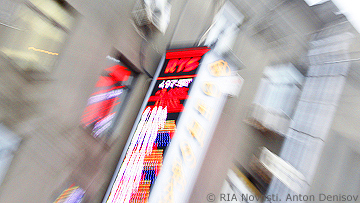Has the Russian equity market turned the corner?

(Business New Europe – bne.eu – Ben Aris in Moscow – March 6, 2015)
So far in 2015 Russia has been one of the best performing equity markets, up 15% year-to-date, following three straight weeks of inflows following the Minsk II ceasefire agreement signed in February.
So far in 2015 Russia has been one of the best performing equity markets, up 15% year-to-date, according to Sberbank CIB, following three straight weeks of inflows following the Minsk II ceasefire agreement signed in February. Some investors, it seems, believe the beginning of the end is here and are taking a punt on super-cheap Russian stocks.
And it is a tempting proposition, if the Russian equity market really has hit bottom. During the last crash, the Russian RTS index fell from an all-time high of 2,487.92 on May 19, 2008 to 492.59 on January 23, 2009. However, in the rest of that year oil prices rapidly recovered from a low of around $43 per barrel, sending the index soaring back to 1,500 by the autumn, trebling the value of investments by those brave enough to take the plunge.
It is not often that investors can make those kinds of returns in the matter of a few months and clearly some portfolio investors believe that another opportunity is presenting itself.
Emerging markets are again coming to the fore as the US market, a star performer over the last year, starts to run out of steam. India remains the most attractive destination, taking in $678nm in the last three weeks alone, pushing its one-year gain to $7.4bn, according to Sberbank CIB. Russia is right behind, taking in $40mn in the same period, to bring its one-year gains to $525mn, while its stocks have significantly outperformed all its BRICS peers thanks to a very low base effect caused by the Ukraine conflict.
Looking at the cumulative fund flow chart, the height of the outflows came in March 2014 when Russia annexed Crimea, but funds started to return afterwards until about October when fighting flared up again in East Ukraine and sentiment turned negative again. Investment fled over the next four months, but the tide seems to have turned once more in February when the German-lead efforts to sign off on another ceasefire deal started to gather momentum. Now that the Minsk II deal is done and a shaky and imperfect ceasefire seems to be holding, inflows are starting to return.
The Russian investment case has been greatly helped by the recovery in the price of oil, which has surged by about a third since lows at the start of the year and was trading at $62 for a barrel of oil at the time of writing.
“After a spike in the price of Brent [on March 5] to nearly $62/bbl, a spectacular rise of more than 5% in one day, Brent is retreating this morning, yet remains above $61/bbl. The violence in Ukraine seems to be abating,” said Slava Smolyaninov of Uralsib in a note.
The relationship between the cost of a barrel of oil and the (dollar-denominated) RTS index value is a close one so any rise in the price of oil usually comes with an equivalent rise in the RTS index. The rule of thumb is that the traditional value of the RTS is 15.5 times the price of oil, which implies the market should be trading with an index value of 945.5, which is slightly above the RTS index’s 930 as of mid-morning on March 6. However, in good times, when Russia is in favour, the multiple rises to 20 times the cost of oil, which implies an RTS level of 1,220.
But with an economic contraction of at least 3% on the cards for this year and a final resolution to the Ukraine conflict still in the distant future, the stock market is unlikely to return to those levels for some time to come.
